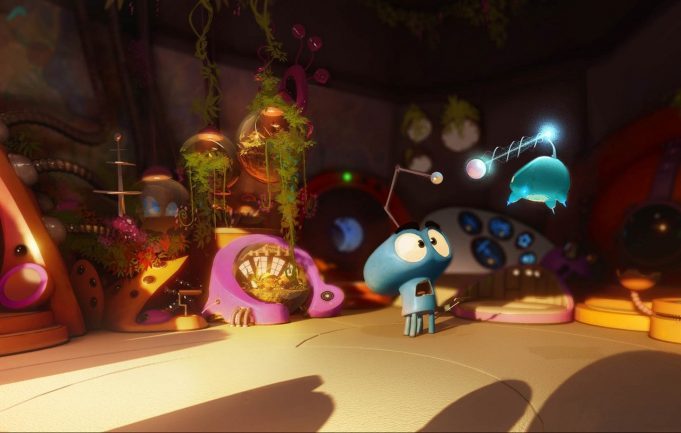 Last year, Baobab Studios’ Eric Darnell was skeptical about adding interactivity to virtual reality stories because he felt like there was a tradeoff between empathy and interactivity. But after watching people experience their first VR short Invasion!, he saw that people were much more engaged with the story and wanted to get more involved. He came to that realization that it is possible to combine empathy and interactivity in the form of compassion acts, and so he started to construct Baobab’s next VR experience Asteroids! around the idea of allowing the user to participate in an act of compassion. I had a chance to catch up with Darnell at Sundance where we talked about his latest thoughts about storytelling in VR, and explored his insights from their first explorations of what he calls “emotional branching.”
Last year, Baobab Studios’ Eric Darnell was skeptical about adding interactivity to virtual reality stories because he felt like there was a tradeoff between empathy and interactivity. But after watching people experience their first VR short Invasion!, he saw that people were much more engaged with the story and wanted to get more involved. He came to that realization that it is possible to combine empathy and interactivity in the form of compassion acts, and so he started to construct Baobab’s next VR experience Asteroids! around the idea of allowing the user to participate in an act of compassion. I had a chance to catch up with Darnell at Sundance where we talked about his latest thoughts about storytelling in VR, and explored his insights from their first explorations of what he calls “emotional branching.”
LISTEN TO THE VOICES OF VR PODCAST
Audio PlayerDarnell says that one of the key ingredients of a story is “character being revealed by the choices that they make under pressure.” Rather than make you the central protagonist as a video game might, in Asteroids! you’re more of a sidekick who can choose whether or not to help out the main characters. This allows an authored story to be told though the main characters that are ultimately independent of your actions, but your “local agency” choices still flavor your experience in the sense that there are different “emotional branches” of the story for how the main protagonists react to you based upon your decisions.
Unpacking the nuances of these emotional branches showed me that Asteroids! was doing some of the most interesting explorations of interactive narrative at Sundance this year, and I would’ve completely missed them had I not had this conversation with him. We explore some of the more subtle nuances of the story, and so I’d recommend holding off on this interview if you don’t want to get too many spoilers (it should be released sometime in the first half of 2017). But Darnell is a master storyteller, and he’s got a lot of really fascinating thoughts about how stories might work in VR that are worth sharing out to the storytellers in the wider VR community.
They’re also doing some interesting experiments of adding in body language mirroring behaviors into the other sidekick characters that are based upon social science research in order to create subtle cues of connecting to the characters and story. There is another dog-like robot the experience that is in the same sidekick class as you where you can play fetch with it and interact with in subtle ways.
Storytelling is a time-based art form that has a physical impact of releasing chemicals in our bodies including cortisol at moments of dramatic tension, oxytocin with character interactions, and dopamine at the resolution of that dramatic tension. Given these chemical reactions, Darnell believes that the classic three-act structure of a story is something that is encoded within our DNA. Storytelling is something that has helped humans evolve, and it’s part of what makes us human. He cites Kenneth Burke saying that “stories are equipment for living.” Stories help us learn about the world by watching other people making choices under pressure.
There’s still a long ways to go before we achieve the Holy Grail of completely plausible interactive stories that provide full global agency while preserving the integrity of a good dramatic arc. It’s likely that artificial intelligence will eventually have a much larger role in accomplishing this, but Asteroids! is making some small and important steps with Darnell’s sidekick insights and “emotional branching” concept. It was one of the more significant interactive narrative experiments at Sundance this year, and showed that it’s possible to combine empathy and interactivity to make a compassionate story.
Support Voices of VR
- Subscribe on iTunes
- Donate to the Voices of VR Podcast Patreon
Music: Fatality & Summer Trip







